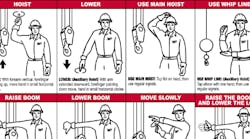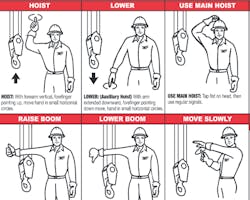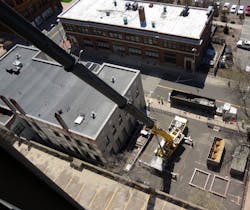Hand Signals You Need to Know During Crane Operations, courtesy of Maxim Crane Works, LP.
Ask any crane operator and they will tell you that one of the main factors for a successful project is coordination.
Working in-sync with your team on the ground is not only crucial for safety but can help your project run smoothly, on schedule and keep the boss happy. With absolute precision and accuracy needed for a job, being able to clearly communicate direction is critical – but this is not always an easy task. Construction sites can be exceptionally loud and busy, meaning verbal communication is at risk of being drowned out by roaring machinery.
So how does an operator, with a load suspended in air, follow instructions from their team? Using the simple but effective method of hand signals. This age-old technique is used by crane operators across the world, aiding them to accurately receive unmistakable directions without the need for fancy equipment or even words!
A Simple Solution
Hand signals provide a simple solution for the communication issues faced by crane operators. Although radios can be used to relay messages across the site, there are some situations when an operator will need extra assistance.
Construction sites are loud. They produce a high level of noise from activities such as digging, piling, and drilling, therefore it can be difficult to convey instruction in an accurate and time efficient way. There are also times when an operator’s directional visibility is obstructed or the visibility of a load area is partially blocked, conducting a lift within these types of conditions can put the operator and the workers around them at serious risk of injury.
Although it recommended to use hand signals during all lifts, it is in these situations when a signal person will definitely be called upon. Easy to understand, hand signals help the operator avoid any potential hazards, completing actions in a safe and timely manner.
The Role of a Signal Person
As the eyes and the ears of a dedicated area or crane, a signal person carries many responsibilities. Before a person can direct the operation of a crane they must first undergo formal training and complete a qualification in crane signaling. In training, a person will not only develop an understanding of standard hand signals, but they will also be required to become familiar with many different types of cranes, how each crane functions and any hand signals specific to particular equipment. The trainee signal person is required to grasp an understanding of the large library of signals without any memory prompts and show competence in recalling these during an examination by a third-party provider.
The signal person is also responsible for preventing injury and accidents to the best of their ability, this is done by following strict procedure during crane operation, for instance standing in clear view of the crane operator, ensuring the operating area is clear of people or hazardous objects and performing one signal at a time to avoid confusion.
The Occupational Safety and Health Administration (OSHA) standard method of signaling must be used when operating a crane unless non-standard hand signals are discussed during the pre-job meeting. OSHA enforces standards and training requirements for safe working environments across multiple industries, including construction in the United States.
Safety First
Safety is the number one concern for crane operators, a person performing the hand signals stand at a vantage point which allows them to view the load area from a perspective that is not visible to the crane operator. From this point, the signal person is able to confirm whether a maneuver is safe to perform and halt all activity if they observe a potential risk.
Cranes have incredible capabilities however if operated incorrectly, they can pose a significant danger to construction workers on the site and in some cases the public. Hand signals have been established as a reliable, low tech and universal way to improve safety during operation and avoid accidents.
Maxim Crane Works, LP is a coast-to-coast provider of crane rental and lifting services. They're found in over 48 locations. Each branch provides management services, including transportation, risk management, safety and insurance programs that are unparalleled in the industry.
To learn more about crane rental, heavy hauling, and specialized rigging services, CLICK HERE
CLICK HERE TO SEE THE FULL LIST OF OSHA STANDARD METHOD HAND SIGNALS.
CLICK THROUGH THE GALLERY TO SEE THE VARIOUS HAND SIGNALS, and DOWNLOAD THE CHART FROM MAXIM CRANE WORKS, LP. The download button is just below the slideshow symbol.










